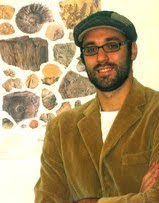Geologic painting by Leonardo da Vinci and Andrea del Verrocchio: the Baptism of Christ (c. 1475). Click on the smaller picture for a full analysis of the painting (from my book 'Geology in Art').
When speaking of geology and art, the first thing that comes to mind is painting. It may be that the association “art–visual arts” is almost automatic, but there is also a historical reason. Pictures are the preferred medium for expressing geology since Renaissance times. Leonardo da Vinci is universally regarded as one of the pioneers of Earth sciences for having recognized and interpreted a number of geologic phenomena. In his famous notebooks da Vinci focused on sedimentary geology and discussed sedimentation, stratification and fossils. Less well-known is the fact that Leonardo expressed his revolutionary geologic theories in his paintings. Geologic features are accurately represented in the Baptism of Christ, the Virgin of the Rocks and St. Anne (Vai 1995, 2003). Leonardo represented stratification in its finest details, including small-scale laminations.
Leonardo was not alone. A great number of artists represented sedimentary layers in extreme detail (see Branagan, 2006). These artists include Botticelli (Pallas and the Centaur), Bellini (St. Jerome Reading in the Countryside), van Eyck (St. Francis Receiving the Stigmata) and Dürer (Lot Fleeing with his Daughters from Sodom). There is no trace before Renaissance times of such a pervasive taste for the accurate representation of natural landscapes.
Leonardo was not alone. A great number of artists represented sedimentary layers in extreme detail (see Branagan, 2006). These artists include Botticelli (Pallas and the Centaur), Bellini (St. Jerome Reading in the Countryside), van Eyck (St. Francis Receiving the Stigmata) and Dürer (Lot Fleeing with his Daughters from Sodom). There is no trace before Renaissance times of such a pervasive taste for the accurate representation of natural landscapes.
Botticelli, Pallas and the Centaur (detail). Note the precise depiction of layering.
The gap between the Middle Ages and the Renaissance can be understood from a quotation taken from Rosenberg (2009): “Art history records that the Western concept of landscape preceded the science of landscape”. Hence it is no coincidence that the emerging of GeoArt is simultaneous with the dawn of modern geology,i.e., the science of the landscape.
Renaissance was a critical period for science, enshrined in the modern scientific method by Galileo Galilei. In this vibrant cultural framework, naturalists followed an observational approach, trying to understand natural objects by describing and depicting them. To Renaissance naturalists the art of illustration was more than mere ornament, as testified by Aldrovandi: “to understand plants and animals there is no better way than to depict them from life” (Aldrovandi, 1572, quoted by Baucon, 2009).
Episodes in the representation of landscape and geologic objects. From my book 'Geology in Art'.
The observational approach was accompanied by the rediscovery of Arabic and Greek geometry, which led to a revolution in understanding spatial relationships and changed the visual perception of the Earth (see Rosenberg, 2009; Branagan, 2006). Although geology continue to evolve rapidly since Leonardo times, geology is still one of the most visual sciences as it is inextricably bound to the understanding of spatial relationships. Without “spatial thinking” (Andrews, 2003) there is no geology.
For these reasons, it can be well said that the origins of Geology are located in a land of convergence between Art and Science.
For these reasons, it can be well said that the origins of Geology are located in a land of convergence between Art and Science.











No comments:
Post a Comment